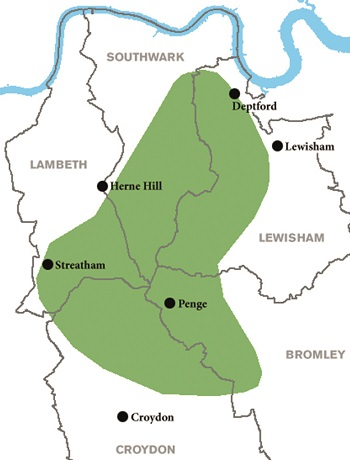What's great about the Great North Wood?
You could argue that the Great North Wood is no longer great, was never in the north, and is barely a wood anymore.
But that would be to do it a disservice.
The Great North Wood is a large area (over 50km2) of south London stretching from Selhurst in the south to Deptford near the Thames in the north. It got its name from the woodland that lay to the north of the large ecclesiastical town of Croydon.
The Industrial Revolution and the Enclosure Acts from the late 18th Century led to the Great North Wood losing its economic validity, and much of it was partitioned and sold off for housing development.
This landscape straddles five current London boroughs - Bromley, Croydon, Lewisham, Southwark and Lambeth.

Now, the Great North Wood is a fragmented series of small woodlands, parks, cemeteries and sports grounds among the urban sprawl of south London. By London Wildlife Trust estimates, remnant ancient woodland (over 400 years old) makes up less than 1% of the overall area of the old wood, and more recent (secondary) woodland makes up 2.9% - so 96% of the woodlands have been lost over time.
There are around 20 woodlands or wooded areas where you can still see green woodpeckers high in the trunks of oak trees and purple hairstreak butterflies floating among the leaves. These include:
But that would be to do it a disservice.
The Great North Wood is a large area (over 50km2) of south London stretching from Selhurst in the south to Deptford near the Thames in the north. It got its name from the woodland that lay to the north of the large ecclesiastical town of Croydon.
 |
| Modern-day Dulwich Woods (source: Wikipedia) |
Throughout the Middle Ages it had a history of strong ownership by local people and was managed for timber (including shipbuilding), charcoal, tannin (for the Bermondsey leather making industries) and firewood.
The Industrial Revolution and the Enclosure Acts from the late 18th Century led to the Great North Wood losing its economic validity, and much of it was partitioned and sold off for housing development.
This landscape straddles five current London boroughs - Bromley, Croydon, Lewisham, Southwark and Lambeth.
Now, the Great North Wood is a fragmented series of small woodlands, parks, cemeteries and sports grounds among the urban sprawl of south London. By London Wildlife Trust estimates, remnant ancient woodland (over 400 years old) makes up less than 1% of the overall area of the old wood, and more recent (secondary) woodland makes up 2.9% - so 96% of the woodlands have been lost over time.
There are around 20 woodlands or wooded areas where you can still see green woodpeckers high in the trunks of oak trees and purple hairstreak butterflies floating among the leaves. These include:
- Dulwich Woods
- Sydenham Hill Wood LNR
- One Tree Hill
- Streatham Common LNR
- The Lawns (Spa Wood)
- Devonshire Road Nature Reserve
- Grangewood Park
- Crystal Palace Park
- New Cross Gate Cutting
- Long Lane Wood
- Biggin Wood
- Nunhead Cemetery LNR
- Beaulieu Heights
- Hillcrest Estate Woods
- Unigate Wood
- Stambourne Woodland Walk
- Hitherwood
- Eliot Bank
- Convent Wood
- Dacres Wood
The London Wildlife Trust (LWT) has just started a "Great North Wood" project, having secured funding from the Heritage Lottery Fund. This is part of their London's Living Landscape initiative. The project will raise people's awareness of this largely forgotten woodland, encouraging residents to explore, enjoy and value the natural wealth on their doorsteps. They will be working with volunteers, community groups and local councils to enhance the surviving green spaces.
This project is made more challenging because the Great North Wood falls under the ownership and control of many different landowners and managers, and is subject to a variety of modern pressures such as overuse, dumping and inconsistent management.
This is an important project in south London, as it will bring focus to many of the key green spaces for wildlife. It is a chance to ensure that the Great North Wood is recognised and valued, before it is lost forever.
In the context of modern London, the Great North Wood has the potential to be great again!
This project is made more challenging because the Great North Wood falls under the ownership and control of many different landowners and managers, and is subject to a variety of modern pressures such as overuse, dumping and inconsistent management.
This is an important project in south London, as it will bring focus to many of the key green spaces for wildlife. It is a chance to ensure that the Great North Wood is recognised and valued, before it is lost forever.
In the context of modern London, the Great North Wood has the potential to be great again!

Comments
Post a Comment